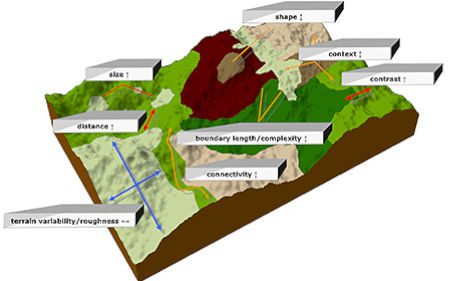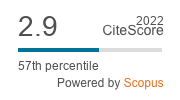The third and fourth dimensions of landscape: Towards conceptual models of topographically complex landscapes
DOI:
https://doi.org/10.3097/LO.201022Keywords:
3D-metrics, Landscape dynamics, Landscape metrics, Scale, Spatial patternsAbstract
Relating spatial patterns to ecological processes is one of the central goals of landscape ecology. The patch-corridor-matrix model and landscape metrics have been the predominant approach to describe the spatial arrangement of discrete elements ("patches") for the last two decades. However, the widely used approach of using landscape metrics for characterizing categorical map patterns is connected with a number of problems. We aim at stimulating further developments in the field of the analysis of spatio-temporal landscape patterns by providing both a critical review of existing techniques and clarifying their pros and cons as well as demonstrating how to extent common approaches in landscape ecology (e.g. the patch-corridor-matrix model). The extension into the third dimension means adding information on the relief and height of vegetation, while the fourth dimension means the temporal, dynamic aspect of landscapes. The contribution is structured around three main topics: the third dimension of landscapes, the fourth dimension of landscapes, and spatial and temporal scales in landscape analysis. Based on the results of a symposium on this theme at the IALE conference in 2009 in Salzburg and a literature review we emphasize the need to add topographic information into evaluations of landscape structure, the appropriate consideration of scales; and to consider the ambiguity and even contradiction between landscape metrics.
References
Agarwal, C., Green, G. M., Grove, J. M., Evans, T. P., & Schweik, C. M. (2004). A review and assessment of land-use change models: Dynamics of space. Time and Human Choice,
Antrop, M. (2007). Reflecting upon 25 years of landscape ecology. Landscape Ecology, 22(10), 1441-1443. doi:10.1007/s10980-007-9170-y
Blaschke, T., & Drǎguţ, L. (2003). Integration of GIS and object-based image analysis to model and visualize landscapes. ISPRS Workshop, , 18-23.
Blaschke, T., & Petch, J. (1999). Landscape structure and scale: Comparative studies on some landscape indices in germany and the UK. Heterogeneity in Landscape Ecology: Pattern and Scale, , 75-84.
Bogaert, J. (2003). Lack of agreement on fragmentation metrics blurs correspondence between fragmentation experiments and predicted effects. Ecology and Society, 7(1) doi:10.5751/es-00495-0701r06
Castilla, G., Larkin, K., Linke, J., & Hay, G. J. (2009). The impact of thematic resolution on the patch-mosaic model of natural landscapes. Landscape Ecology, 24(1), 15-23. doi:10.1007/s10980-008-9310-z
Corry, R. C., & Nassauer, J. I. (2005). Limitations of using landscape pattern indices to evaluate the ecological consequences of alternative plans and designs. Landscape and Urban Planning, 72(4), 265-280. doi:10.1016/j.landurbplan.2004.04.003
Dorner, B., Lertzman, K., & Fall, J. (2002). Landscape pattern in topographically complex landscapes: Issues and techniques for analysis. Landscape Ecology, 17(8), 729-743. doi:10.1023/A:1022944019665
Drǎguţ, L., Tiede, D., & Levick, S. R. (2010). ESP: A tool to estimate scale parameter for multiresolution image segmentation of remotely sensed data. International Journal of Geographical Information Science, 24(6), 859-871. doi:10.1080/13658810903174803
Forman, R. T. T. (1995). Land Mosaics: The Ecology of Landscapes and Regions,
Forman, R. T. T., & Godron, M. (1986). Landscape Ecology,
Gustafson, E. J. (1998). Quantifying landscape spatial pattern: What is the state of the art? Ecosystems, 1(2), 143-156. doi:10.1007/s100219900011
Haines-Young, R., & Chopping, M. (1996). Quantifying landscape structure: A review of landscape indices and their application to forested landscapes. Progress in Physical Geography, 20(4), 418-445. doi:10.1177/030913339602000403
Hargis, C. D., Bissonette, J. A., & David, J. L. (1998). The behavior of landscape metrics commonly used in the study of habitat fragmentation. Landscape Ecology, 13(3), 167-186. doi:10.1023/A:1007965018633
Hoechstetter, S. (2009). Enhanced Methods for Analysing Landscape Structure: Landscape Metrics for Characterising Three-Dimensional Patterns and Ecological Gradients,
Hoechstetter, S., Walz, U., Dang, L. H., & Thinh, N. X. (2008). Effects of topography and surface roughness in analyses of landscape structure - A proposal to modify the existing set of landscape metrics. Landscape Online, 3(1), 1-14. doi:10.3097/LO.200803
Jaeger, J. A. G. (2000). Landscape division, splitting index, and effective mesh size: New measures of landscape fragmentation. Landscape Ecology, 15(2), 115-130. doi:10.1023/A:1008129329289
Jelinski, D. E., & Wu, J. (1996). The modifiable areal unit problem and implications for landscape ecology. Landscape Ecology, 11(3), 129-140. doi:10.1007/BF02447512
Käyhkö, N., & Skånes, H. (2006). Change trajectories and key biotopes - assessing landscape dynamics and sustainability. Landscape and Urban Planning, 75(3-4), 300-321. doi:10.1016/j.landurbplan.2005.02.011
Kent, M. (2007). Biogeography and landscape ecology. Progress in Physical Geography, 31(3), 345-355. doi:10.1177/0309133307079059
Kent, M. (2009). Biogeography and landscape ecology: The way forward - gradients and graph theory. Progress in Physical Geography, 33(3), 424-436. doi:10.1177/0309133309338119
Lang, S., Walz, U., Klug, H., Blaschke, T., & Syrbe, R. -. (2008). Landscape metrics – a toolbox for assessing past, present and future landscape structures. Geoinformation technologies for geocultural landscapes: European perspectives (pp. 207-234)
Levin, S. A. (1992). The problem of pattern and scale in ecology. Ecology, 73(6), 1943-1967. doi:10.2307/1941447
Li, H., & Reynolds, J. F. (1995). On definition and quantification of heterogeneity. Oikos, 73(2), 280-284. doi:10.2307/3545921
Li, H., & Wu, J. (2007). Landscape pattern analysis: Key issues and challenges. Key topics in landscape ecology (pp. 39-61) doi:10.1017/CBO9780511618581.004
Li, H., & Wu, J. (2004). Use and misuse of landscape indices. Landscape Ecology, 19(4), 389-399. doi:10.1023/B:LAND.0000030441.15628.d6
McGarigal, K., & Cushman, S. A. (2005). The gradient concept of landscape structure. Issues and perspectives in landscape ecology (pp. 112-119) doi:10.1017/CBO9780511614415.013
McGarigal, K., & Marks, B. J. (1995). FRAGSTATS: Spatial pattern analysis program for quantifying landscape structure. FRAGSTATS: Spatial Pattern Analysis Program for Quantifying Landscape Structure,
McGarigal, K., Tagil, S., & Cushman, S. A. (2009). Surface metrics: An alternative to patch metrics for the quantification of landscape structure. Landscape Ecology, 24(3), 433-450. doi:10.1007/s10980-009-9327-y
Morgan, J. L., & Gergel, S. E. (2010). Quantifying historic landscape heterogeneity from aerial photographs using object-based analysis. Landscape Ecology, 25(7), 985-998. doi:10.1007/s10980-010-9474-1
Moser, B., Jaeger, J. A. G., Tappeiner, U., Tasser, E., & Eiselt, B. (2007). Modification of the effective mesh size for measuring landscape fragmentation to solve the boundary problem. Landscape Ecology, 22(3), 447-459. doi:10.1007/s10980-006-9023-0
Müller, F. (1998). Gradients in ecological systems. Ecological Modelling, 108(1-3), 3-21. doi:10.1016/S0304-3800(98)00015-5
Müller, F., & Steinhardt, U. (2003). Landscape modelling and landscape analysis. Ecological Modelling, 168(3), 215-216. doi:10.1016/S0304-3800(03)00137-6
Naveh, Z., & Lieberman, A. S. (1984). Landscape ecology: Theory and application. Landscape Ecology: Theory and Application.,
O'Neill, R. V., Hunsaker, C. T., Timmins, S. P., Jackson, B. L., Jones, K. B., Riitters, K. H., & Wickham, J. D. (1996). Scale problems in reporting landscape pattern at the regional scale. Landscape Ecology, 11(3), 169-180. doi:10.1007/BF02447515
O'Neill, R. V., Krummel, J. R., Gardner, R. H., Sugihara, G., Jackson, B., DeAngelis, D. L., . . . Graham, R. L. (1988). Indices of landscape pattern. Landscape Ecology, 1(3), 153-162. doi:10.1007/BF00162741
Openshaw, S., & Taylor, P. J. (1979). A million or so correlation coefficients: Three experiments on the modifiable areal unit problem. Statistical Applications in the Spatial Sciences, , 127-144.
Potschin, M., & Haines-Young, R. (2006). "Rio+10", sustainability science and landscape ecology. Landscape and Urban Planning, 75(3-4), 162-174. doi:10.1016/j.landurbplan.2005.03.005
Price, B., McAlpine, C. A., Kutt, A. S., Phinn, S. R., Pullar, D. V., & Ludwig, J. A. (2009). Continuum or discrete patch landscape models for savanna birds? towards a pluralistic approach. Ecography, 32(5), 745-756. doi:10.1111/j.1600-0587.2009.05670.x
Riitters, K., Wickham, J., & Coulston, J. (2004). Use of road maps in national assessments of forest fragmentation in the united states. Ecology and Society, 9(2) doi:10.5751/ES-01210-090213
Riitters, K. H., Wickham, J. D., O'Neill, R. V., Jones, K. B., Smith, E. R., Coulston, J. W., . . . Smith, J. H. (2002). Fragmentation of continental united states forests. Ecosystems, 5(8), 815-822. doi:10.1007/s10021-002-0209-2
Rollins, M. G., Keane, R. E., & Parsons, R. A. (2004). Mapping fuels and fire regimes using remote sensing, ecosystem simulation, and gradient modeling. Ecological Applications, 14(1), 75-95. doi:10.1890/02-5145
SAUNDERS, D. A., HOBBS, R. J., & MARGULES, C. R. (1991). Biological consequences of ecosystem fragmentation: A review. Conservation Biology, 5(1), 18-32. doi:10.1111/j.1523-1739.1991.tb00384.x
Saura, S., & Martínez-Millan, J. (2000). Landscape patterns simulation with a modified random clusters method. Landscape Ecology, 15(7), 661-678. doi:10.1023/A:1008107902848
Scheiner, S. M. (1992). Measuring pattern diversity. Ecology, 73(5), 1860-1867. doi:10.2307/1940037
Turner, M. G. (1989). Landscape ecology: The effect of pattern on process. Annual Review of Ecology and Systematics.Vol.20, , 171-197. doi:10.1146/annurev.es.20.110189.001131
Turner, M. G. (2005). Landscape ecology: What is the state of the science? doi:10.1146/annurev.ecolsys.36.102003.152614
Turner, M. G., & Gardner, R. H. (1991). Quantitative Methods in Landscape Ecology,
Turner, M. G., O'Neill, R. V., Gardner, R. H., & Milne, B. T. (1989). Effects of changing spatial scale on the analysis of landscape pattern. Landscape Ecology, 3(3-4), 153-162. doi:10.1007/BF00131534
Wickham, J. D., Riitters, K. H., Wade, T. G., & Coulston, J. W. (2007). Temporal change in forest fragmentation at multiple scales. Landscape Ecology, 22(4), 481-489. doi:10.1007/s10980-006-9054-6
Wiens, J. A. (1989). Spatial scaling in ecology. Functional Ecology, 3(4), 385-397. doi:10.2307/2389612
With, K. A., & King, A. W. (1997). The use and misuse of neutral landscape models in ecology. Oikos, 79(2), 219-229. doi:10.2307/3546007
Woodcock, C. E., & Strahler, A. H. (1987). The factor of scale in remote sensing. Remote Sensing of Environment, 21(3), 311-332. doi:10.1016/0034-4257(87)90015-0
Wu, J. (2006). Landscape ecology, cross-disciplinarity, and sustainability science. Landscape Ecology, 21(1), 1-4. doi:10.1007/s10980-006-7195-2
Wu, J., & Hobbs, R. J. (2007). Key topics in landscape ecology. Key topics in landscape ecology (pp. 1-297) doi:10.1017/CBO9780511618581

Downloads
Published
How to Cite
Issue
Section
License
Copyright (c) 2019 Lucian Drăguţ, Ulrich Walz, Thomas Blaschke

This work is licensed under a Creative Commons Attribution 4.0 International License.










